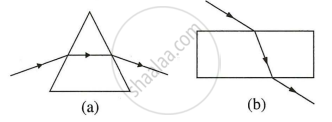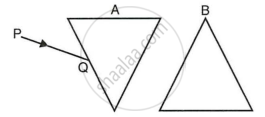Advertisements
Advertisements
प्रश्न
Which of the two prism, A made of crown glass and B made of flint glass, deviates a ray of light more?
उत्तर
B made of flint glass. Because it has higher refractive index.
APPEARS IN
संबंधित प्रश्न
Define the term angle of deviation.
The deviation produced by a prism is independent of the angle of incidence and is same for all the colours of light.
Diagrams (a) and (b) in figure below show the refraction of a ray of light of single colour through a prism and a parallel sided glass slab respectively.

- In each diagram, label the incident, refracted, emergent rays and the angle of deviation.
- In what way the direction of emergent ray in the two cases differ with respect to the incident ray? Explain your answer.
A light ray of yellow colour is incident on an equilateral glass prism at an angel of incidence equal to 48° and suffers minimum deviation by an angle of 36°.
- What will be the angle of emergence?
- If the angle of incidence is changes to (a) 30°, (b) 60°, state whether the angle of deviation will be equal to, less than or more than 36°?
A ray of light is normally incident on one face of an equilateral glass prism. Answer the following:
What is the angle of incidence on the first face of the prism?
In following figure shows two identical prisms A and B placed with their faces parallel to each other. A ray of light of single colour PQ is incident at the face of the prism A. Complete the diagram to show the path of the ray till it emerges out of the prism B.

[Hint: The emergent ray out of the prism B will be parallel to the incident ray PQ]
When white light enters a prism, it gets split into its constituent colours. This is due to:
Draw a ray diagram showing the dispersion through a prism when a narrow beam of white light is incident on one of its refracting surfaces. Also indicate the order of the colours of the spectrum obtained.
Explain the phenomenon of dispersion of white light through a glass prism, using suitable ray diagram.
Name the colour of white light which is deviated the least on passing through a prism.
